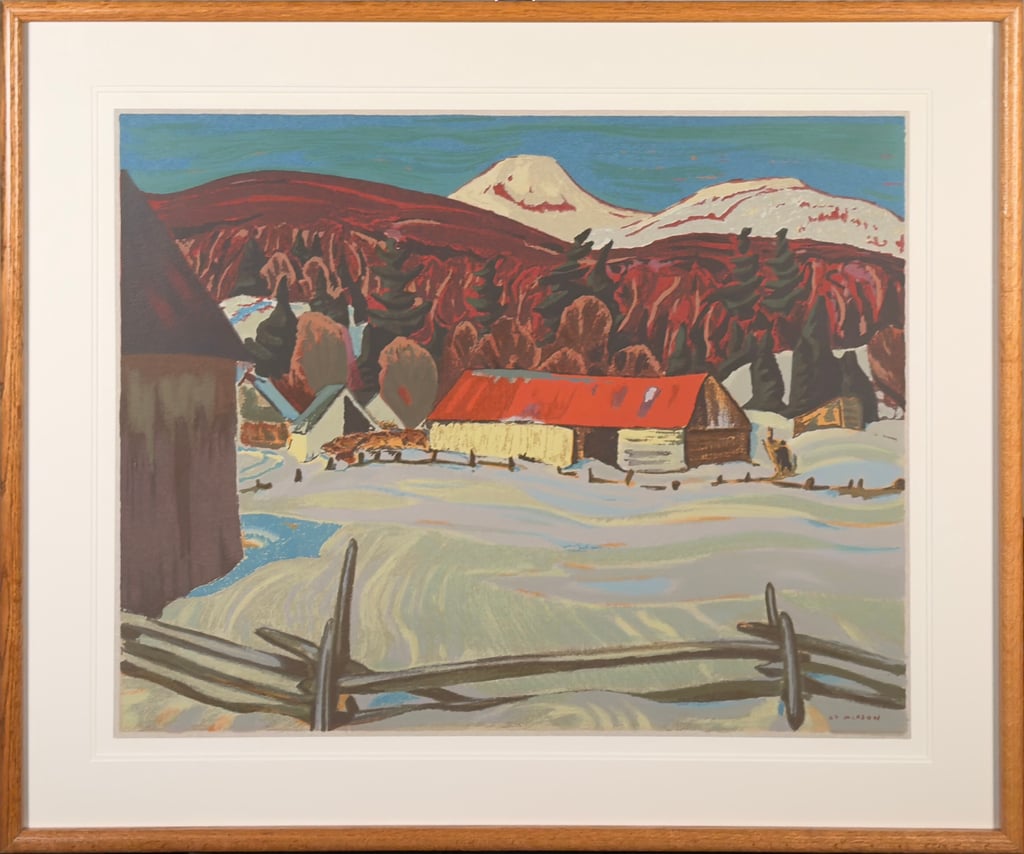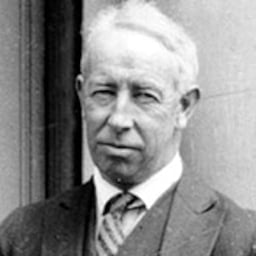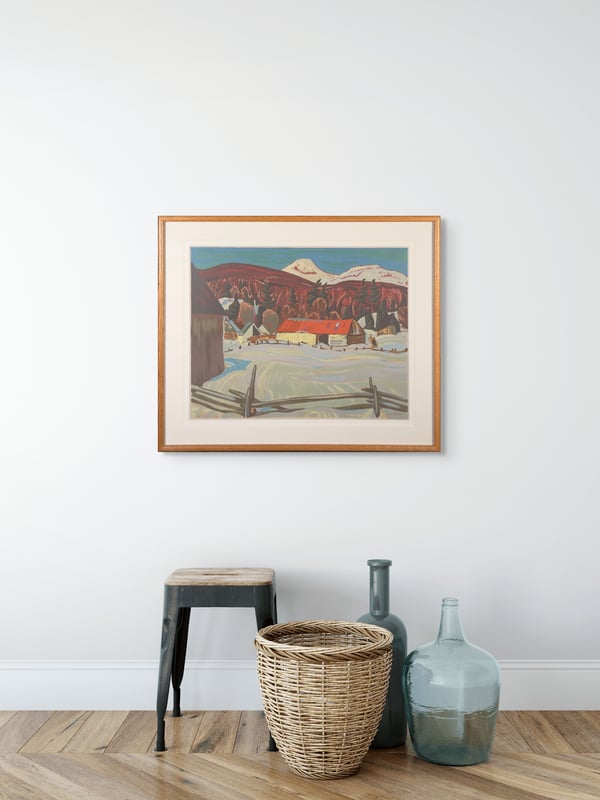The Red Barn
29 x 35 in (73.7 x 88.9 cm) including frame
Sampson-Matthews LTD., Toronto
Private Collection, Winnipeg
(Includes Buyer's Premium)


Alexander Young Jackson
CGP, Group of Seven, Order of Canada, RCA

Alexander Young Jackson was born the third of six children in a house on Mackay Street, Montreal in 1866. His father was absent for the majority of his life, and Jackson often thought of him as a failure. A.Y. Jackson did well at school and went to work at 12 years old for the British Engraving Company. During idle times at his job, Jackson would draw and copy from newspapers. When Jackson’s artistic side was noticed, he was moved to the art department and became an assistant to Arthur Nantel.
Taking quickly to art and developing a distaste for commercial art ventures, Jackson found himself gravitating to Canadian art and recognizing there was a general apathy towards it within Canada. At 23 he moved to a photo engraving company but found he was called to Europe to study.
In 1907, A.Y. Jackson went to study at L’Academie Julian in Paris, studying under Jean-Paul Laurens. His instructor opposed experimentation in painting, and Jackson was taught conservatively. Despite the restrictive pedagogy, Jackson went on to help create a new and experimental form of Canadian landscape art. While staying in Étaples, Jackson’s work was influenced heavily by the Impressionists.
Early in his career, A.Y Jackson had little commercial success. After his second trip to Paris, Jackson received a letter from J.E.H Macdonald inquiring if ‘Edge of the Maple Wood’ (1910) was available because Lawren Harris wanted to purchase it. The letter also mentioned Macdonald’s belief that the art of Canada ought to rely less on European conventions and have Canadians paint their country as they saw it. His friendships with Macdonald and Harris would lead to his acquaintance with Dr. James MacCullum and his subsidizing Jackson’s painting for a year. MacCallum would go on to make the same offer to Tom Thomson. The two shared a studio in Toronto and cultivated a symbiotic friendship; Jackson taught Thomson about colour and he taught Jackson about the outdoors.
He was injured in 1916 when a bullet lodged in his shoulder after enlisting in the 60th battalion. After the injury, he started working as a painter for the Canadian War Records. He began with portraits but gradually leaned towards landscapes, having always preferred them. After the war, he would go on to capture the ‘spirit of the country’ in paint with Lawren Harris, Arthur Lismer, J.E.H Macdonald, Fred Varley, Frank Johnston, and Frank Carmichael.
The Group of Seven was received with praise and scrutiny. A. Y. Jackson believed the criticism boiled down to a naive preference for European art traditions among Canadians. Financially, the group suffered in the early years because their work was seen as too risky to buy; it was ridiculed and misunderstood. Their common goal of painting the country as they saw it in a uniquely Canadian fashion proved successful during their lifetimes, as the general opinion towards the Group of Seven’s work changed. Now, paintings from the Algonquin school (as they were also known) hang in private collections, galleries, and art museums across the country.
The Group of Seven is heralded as one of the finest groups of painters for building a uniquely Canadian visual language. The Group of Seven dissolved in 1933. A. Y. Jackson continued to paint across the country until his severe stroke in 1968. He lived with Robert and Signe McMicheal in Kleinburg, Ontario, before spending his final years in a nursing home. He is buried on the grounds of the McMicheal gallery with Frederick Varley, Lawren Harris, and Arthur Lismer.
March Canadian Fine Art Auction
March 13 - March 27, 2025
212 McDermot Ave, Winnipeg MB
(204) 255-5690
mayberryfineart.com
[email protected]
Contact us to make an appointment to preview this item or to sell similar works.
|
Bidding Range
|
Increment
|
|---|---|
| $0.00 - $50.00 | $1.00 |
| $50.00 - $100.00 | $5.00 |
| $100.00 - $500.00 | $10.00 |
| $500.00 - $1,000.00 | $25.00 |
| $1,000.00 - $5,000.00 | $50.00 |
| $5,000.00 - $10,000.00 | $100.00 |
| $10,000.00 - $20,000.00 | $200.00 |
| $20,000.00 - $50,000.00 | $500.00 |
| $50,000.00 - $100,000.00 | $1,000.00 |
| $100,000.00+ | $5,000.00 |
Login or register a BidLots.com account to participate in any auction. Track specific lots and artists with real-time notifications on all bidding activity.
Bidding approval requires three simple steps:
1. Create a Bid Lots account
2. Confirm your email address
3. Create a valid billing profile
Bid Lots and/or the auctioneer may choose to revoke your bidding privileges if your account is not in good standing or your activity is in conflict with our standard terms and conditions of sale.
The buyer’s premium is an additional percentage charged to the winning bidder. The buyer’s premiums may vary from auction to auction, typically ranging from 10% to 20%. Buyer’s premiums will be displayed on detailed lot listings and paddle registration forms.
Bidding begins at the reserve price and advances at set increments based on the bidding range. The specific bidding increments may vary from auction to auction, however the next bid and subsequent increments will always be clearly defined on detailed lot listings. Maximum Bids and Single Bids can only be placed within the pre-defined bidding increments ensuring that no two bidders can place identical bids on an item. View individual lot detail pages to see a complete range of bidding increments for that item.
Requests to cancel a single bid are at the sole descretion of the auctioneer. Maximum bids can be increased but cannot be decreased unless premitted by the auctioneer. Requests to cancel a bid or to alter a maximum bid will be denied if the specific lot is scheduled to close in less than 24 hours or if the lot has significant interest or activity.
To request that a bid be cancelled or to change a maximum bid use the "Ask a question" button on the detailed lot listing.
You will receive an email notification when you have successfully won an auction. You will also see the item listed on your "Bidding Results" page and if you are logged into the site you will see a highlighted message on the auction catalogue pages and auction listings.
Shipping requirements may vary on different items depending on location and size or weight of an item. When registering for a specific auction you will be provided options to clarify your preferred shipping instructions. The auctioneer will also review and provide specific shipping quotes or options following the close of an auction. If you have specific shipping requirements or are unsure of the shipping constraints on a specific item please contact the auctioneer prior to bidding.
Following the close of an auction the auctioneer will provide a detailed invoice for all items you have won. They may contact you before a final invoice is prepared to confirm or review specific shipping instructions. Payment is due once a final invoice is provided and can be submitted online by credit card, or made by EFT (Electronic Fund Transfer), bank draft or international wire transfer. Any outstanding balance will be automatically charged to your registered credit card 5 days following the close of an auction.


